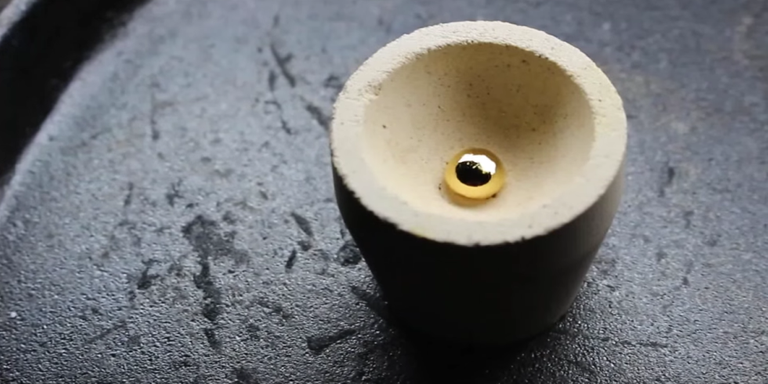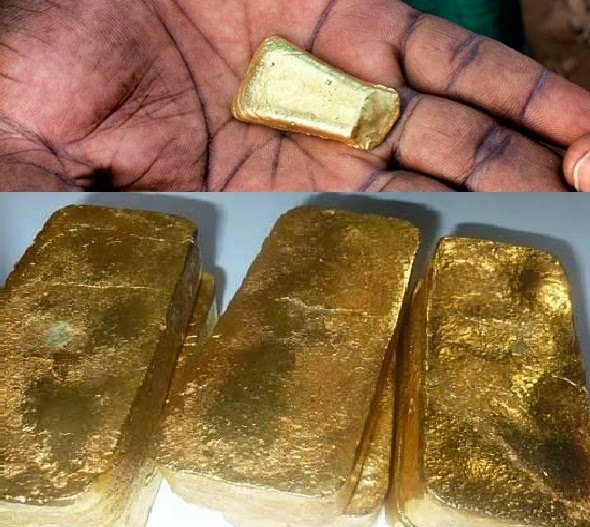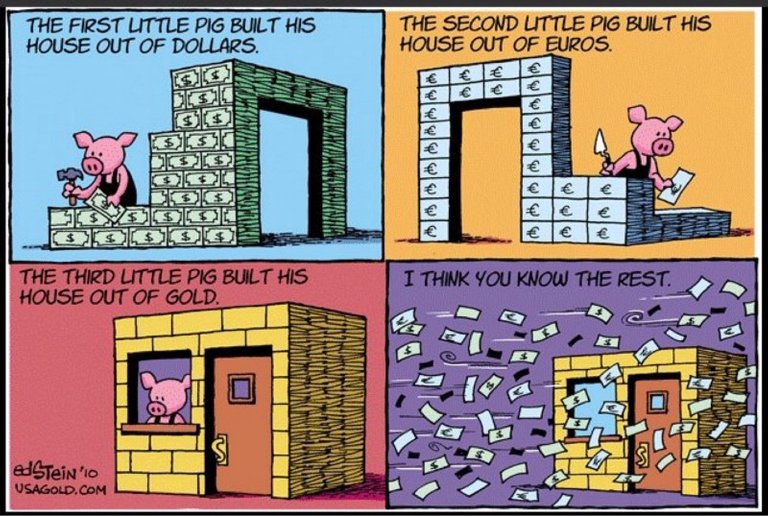

I've been going back over my own posting history, reminiscing and found an earlier post from September where I mentioned that I would explain the process involved in refining gold at home if the posting reached a certain value. As it turns out, it did reach that goal during the 30 day period. So I wanted to tie up that lose end with this post.
Think about this for a second. Right now you can buy proven gold mines in the USA for as little as $2,000 USD.
That's less than the cost of 2oz of gold and if you don't have that kind of money, you can also mine electronic (eWaste), in a similar fashion. Note: If going the ewaste route, carefully strip down the electronics, leaving only the circuit boards and recycle the plastics and metals using normal recyclers in your area.
But if it's a literal gold mine, Why doesn't everyone do this?
Because it isn't worth their time at current prices.
A single person can use a pick and shovel and mine out 1/8th of a ton of serviceable ore.
That's assuming you work like a madman with no breaks and manage to somehow only get at actual ore bearing rock.
You need to do this every day for 8 days to get a full ton. Alternatively eWaste has varying amounts of gold in some cases even more than 1oz per ton, but you really want older computers and electronics for this. Anything pre 2001 has significantly more gold in it than anything since that time and generally the older the better as long as it's solid state electronics since precious metals weren't widely used in transistorized and vacuum tube electronics.
Whether it's rocks or circuit boards, we're going to call it ore from here out.
Assayed good ore has a gold content of 1oz per ton and we should use techniques that assume this value since it's part of the standard process.
Once you have a ton of something, whether it's rocks or circuit boards, your first step is to pulverize it.
Pulverizing increases the surface area and makes the remaining steps possible.
You take the pulverized ore and place it into a crucible along with powered lead. You need about 1/10th oz of powdered lead for every ounce of other material. You heat the crucible to 1100° C. The crucible will absorb a lot of the impurities, and the lead will have an affinity for the precious metals, dragging them down to the bottom while most of the junk metal will slag up at the top.

When done, you'll be left with a drop of metal called "an assayer's button".
Let it cool, but you aren't done yet. You still have a mix of all the metals in the sample, not just precious metals and now you need to separate them. Some will be easy because it's visible as slag and you can just break it off.
Weigh your button first, then mix some nitric acid and hydrocloric acid in a molar (non-diluted) ratio of 1:3
forming Aqua regia (from Latin, lit. "royal water" or "king's water"). Aqua regia is a yellow-orange fuming liquid, so named by alchemists because it can dissolve the noble metals gold and platinum, though not all metals. What's most important to note about this unique liquid is that if you get it on your skin, or the fumes anywhere near your mouth or eyes there isn't much you can do about it except die, painfully.
The nice thing about this stuff is it has a shelf life measured in centuries and you can keep reusing it pretty much forever, just top it off when it gets a little low.
This acid is highly selective and will only take precious metals into solution.
Pulverize your assay button and put the powder in the aqua regia and mix or stir overnight, it can take a long time depending on how strong the acid mix was.
At some point you now have moderately clear acid yellow/orange with a whole bunch of black junk at the bottom.
Pass the acid through a filter. The black junk is what we call "pot metal". It's a mix of nickle, iron, zinc, you name it and it's probably in there.
You can keep repeating this process until the aqua regia is too pregnant to take any more.
A single liter of this stuff was used to hide the nobel prizes on display at the copenhagen institute from nazis.
So depending on the quality of input materials it can take a very, very long time to full impregnate it.
Either way your gold is now sitting as solute atoms in the acid, same with platinum, silver, palladium etc.
The goal now is to get the precious metals out through a process called precipitation.
Each metal is going to be sensitive to a particular chemical. You want to start with the heaviest metals first, which is platinum. Add ammonium chloride and the platinum (as well as rhodium) will precipitate out after some time.
Rinse dry and weigh the powder.
Next add Sodium Metabisulfite to get the gold to precipitate.
Again rinse, dry and weigh it.
Keep repeating that down the line for each of your metals.
At each step you weighed the results and these weights will tell you how much you earned and what the various ratios are. If you had a really good day and got an entire ton, it's going to be around 1/16th of an oz, with platinum and gold coming in at a few grams, if that much.

Once you have a few ounces of gold powder, you can melt it into Dore' bars. Which are about 95% pure.
You can then use the Dore bars to construct a "Wohlwill Process" setup which will finish the refining and result in pure gold.
Instead of aqua regia, you use pure molar HCL.
You carefully evaporate off much of the liquid , then you pass an electric current through the acid using the Dore' bar as an anode and thin sheets of gold, or stainless steel as the cathode. The current will pass from the anode to the cathode and drag the gold atoms along for the ride depositing them as 99.99999% pure gold.
A similar process can be used in the Aqua Regia stage of earlier refining, by using electrolysis instead of chemical reactions, to produce additional Dore bars. This saves money on the chemical used to precipitate the metals, at the expense of leaving you with a bit of hit or miss on the purity of your final product and requiring a second stage Wohlwill process for finishing. The regia is more aggressive than the pure HCL though and will require both more current and more feedstock.
If you attach a large electromagnet to the bottom of the device you'll keep any ferrous metals that might be in the pot metal, from migrating too. It's much more efficient in terms of time, but far more costly in terms of electricity.
As always, this post is 100% Steem Powered!
Enjoy!
Now that the cat is out of the bag, is the price of gold set for a steep decline due to massive new supplies entering the market? Thanks a lot, @williambanks lol
Great post. Here they have a huge tank 300' across and about 30 feet deep with a giant hydraulic powered stir. They throw in the ore, lots of water, and a truck load of salad oil. They stir for a while, and the gold floats up in the salad oil then let it stop and drain off the salad oil through a filter.
Uhh ok, so that's called suspensory filtration.
It's crushing the ore and handles that pulverizing stage I mentioned. But the oil is not gold. Tiny pieces of gold and other metals will settle into a layer similar to fractional distillation and then can be drawn off for further refinement.
But it still needs refining afterwards because this technique is not going to be very selective. Everything from nickle to rhodium would be in that layer. Meaning the amount of acid per oz of material would be reduced because you've removed anything soluble in oil by drawing off the oil.
You sure this is actual salad oil? I have a feeling they're calling it that, but it's a chlorine / glycol mix of some sort.
That would cause the various metals to form salts which are easier to deal with.
yes, great post
nice gold, thank you for share
I rather just buy it as cheap as it is now... in 1oz Buffalo form... but will of course take Maple Leafs, Krugerrand, Pandas.... etc. let them do the work.
Very informative, tho as you point out not so practical for most. Far safer to let others do the reclamation.
If you are inclined to do your own electronics salvage for the gold content, I hear Pentium Pro CPUs yield a high percentage of gold compared with other sources.
Those are monstrously large chips. The PPro was one of the first ultra high perf. systems I build back in the day. Hard to believe (in some ways) that was almost 20 years ago!
Similar to extracting gases from air.
Yes, @williambanks but, everyone can use gold as sound, honest money through a Goldmoney account.

His theory is crackpot.
The demo works because the microwaves energize the metals in the silicate slag, mixing and draging them along where they begin to settle out in layers according to weight.
What he's calling "monoatomic gold" in the black sands and magnetite are actually Iron Pyrite which occurs any time you react iron with sulfur (acid rain anyone?). Some black sand does have about 0.00003% gold in it though, but the energy consumed by the microwave and the resources consumed in the flux are going to cost more than the gold you do extract. Furthermore, this process is more likely to produce pyrite than gold.
The reason his "gold from beer bottles" is a different color isn't because it's gold mixed with rhodium or platinum as he explains, but because iron and chromium are used to give the beer bottles their color. These are reacted with sulfur to produce pyrite.
https://en.wikipedia.org/wiki/Glass_coloring_and_color_marking
https://en.wikipedia.org/wiki/Pyrite
http://goldrefiningforum.com/~goldrefi/phpBB3/viewtopic.php?t=16968
http://microwavegoldkiln.com/
All things being equal, the simplest solution is usually correct. :D